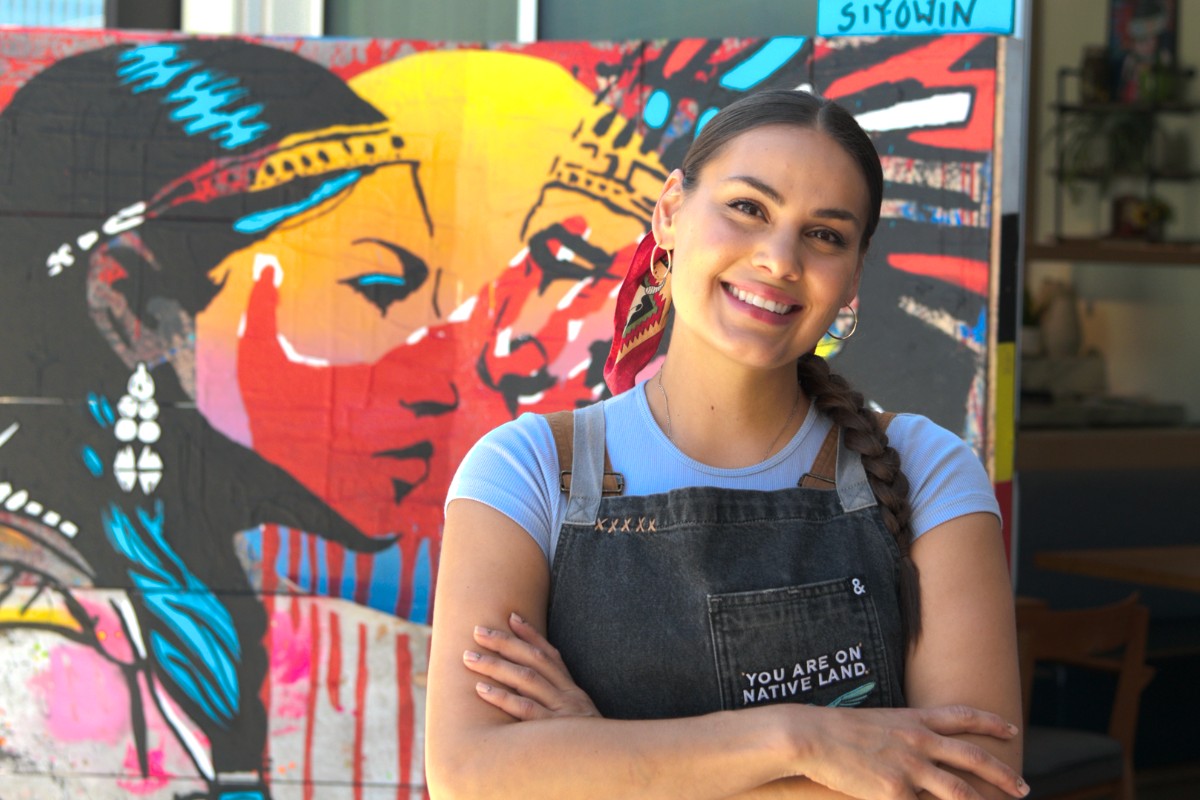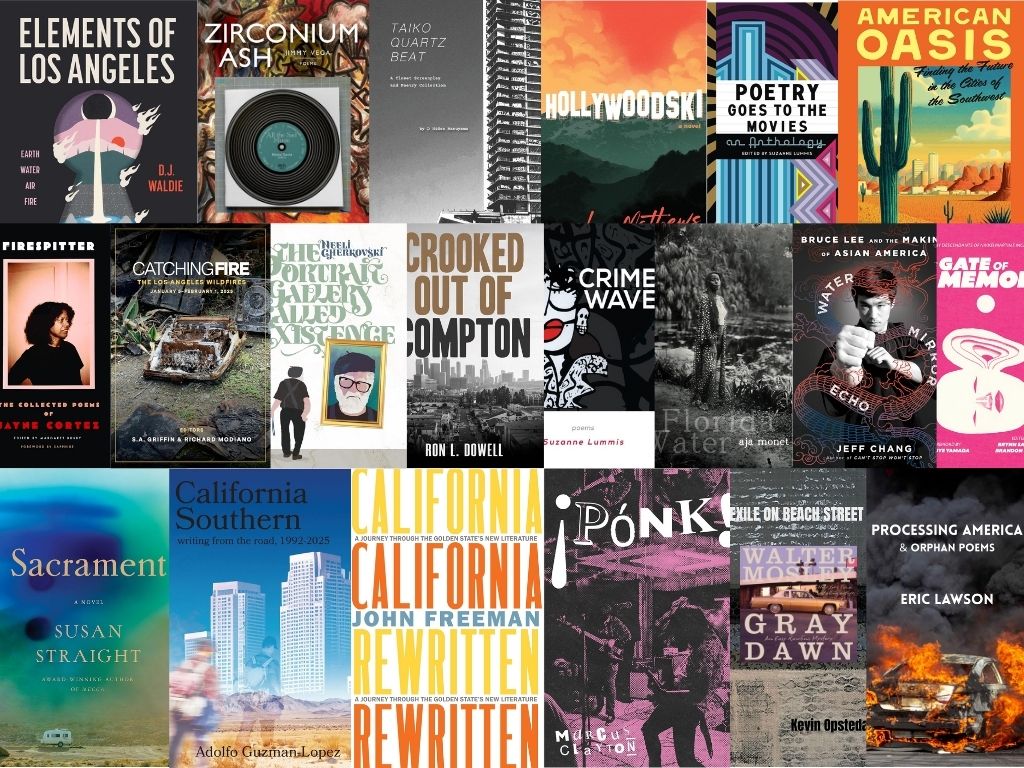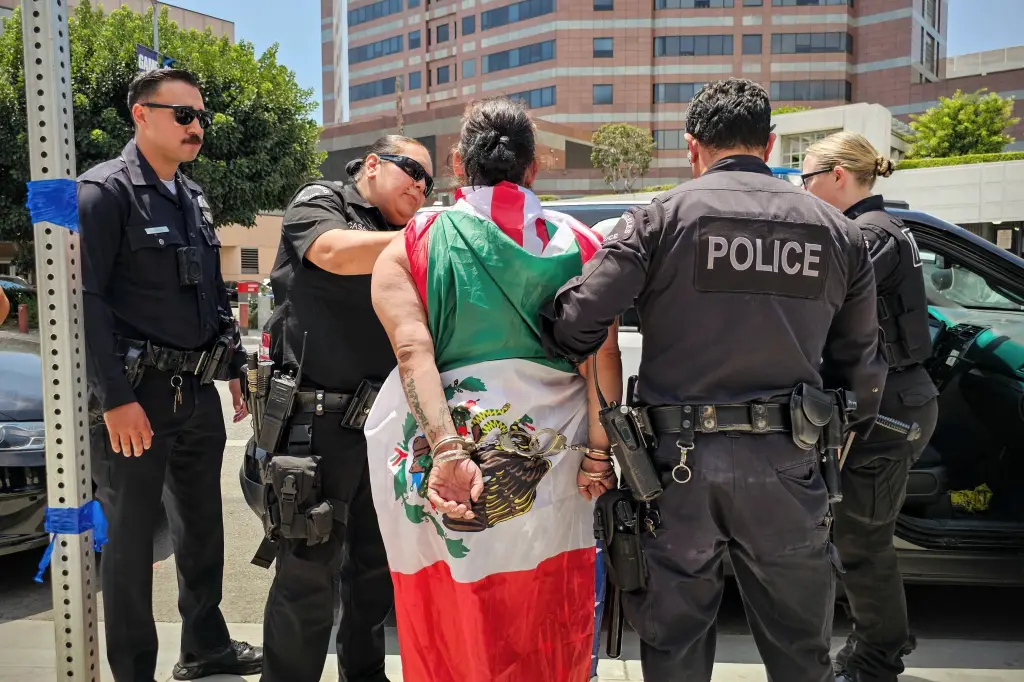While you may be used to hearing Indigenous land acknowledgments before major sports events or graduation ceremonies at L.A.'s exorbitantly priced universities, until now, you’d be out of luck when looking for a restaurant that centers Native American cooking in Los Angeles.
Chef Pyet DeSpain is changing that with a residency at Abernethy’s, the restaurant at The Music Center in Downtown, where an “Emerging Chefs Program” regularly inserts different chefs into the kitchen to execute their visions.
DeSpain will offer her menu, which combines Mexican and Native American influences, until the spring of 2025.
DeSpain was the first chef to win on Gordon Ramsay’s Next Level Chef T.V. show. She’s recently given a TED Talk detailing her upbringing with her father’s taquería-owning Mexican family and her mother’s Prairie Band Potawatomi Nation Tribe. Watching women make corn soup spurred her own drive to cook while she was living on the Osage Reservation as a young woman.
This past Sunday, Pyet served bison burgers to Hollywood stars at Disney’s Emmys after-party in an apron bearing a patch that said, “You are on Native land.” Having long worked as a private chef in L.A., celebrities may not really phase her, but she was over the moon to connect with the industry’s Indigenous talent.
“It was honestly like the best party I'd ever been to in my life,” DeSpain tells L.A. TACO. “I got to just see all of the people that I've admired amongst all the Native American creatives that are in the film industry, and people that I've kind of been messaging back and forth on social media, and just kind of gushing.”
Meeting Lily Gladstone, star of Killers of the Flower Moon, and inviting her to dine at Abernethy’s was a particular highlight.
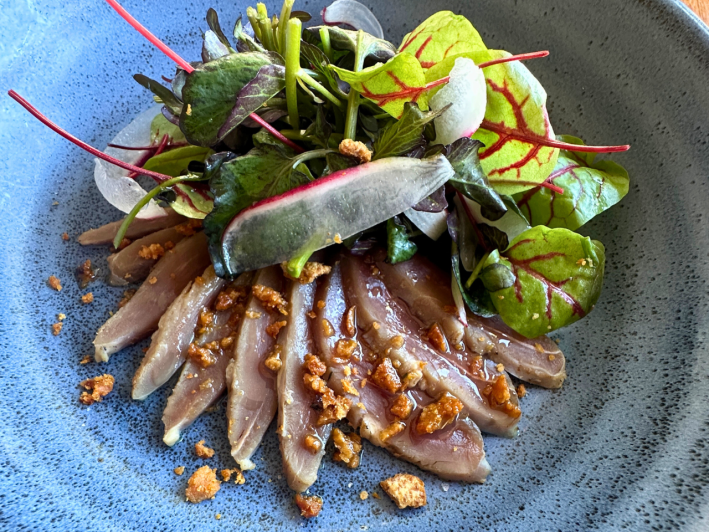
DeSpain would likely be eager to serve Gladstone her smoked duck ham with duck skin chicharrones. This dish not only exemplifies her fusion of Mexican-and-Indigenous North American ingredients and showcases her passion for smoking foods, but it is also one she’s worked especially hard on creating for her residency.
“I love ham, and of course, in Mexican cuisine, we eat a lot of chicharrón, and I wanted to create a chicharrón from the duck skin,” ” DeSpain says. “And it's fatty; it can be dried out, fried, and things like that, so that's the closest thing to emulating a chicharron that I can find within the ingredients from the Americas. And so we cured it with a lot of spices, some juniper berries, and some herbs, so we cured it and then smoked it… [it’s] one of the most innovative dishes that I've created as a chef.”
DeSpain credits her ventures into Indigenous-Mexican fusion cuisine to looking inward while trying to distinguish herself as a private chef in L.A. She’s keen to bring her style to L.A. eaters through the residency.
“For me, I'm most excited about the experience of being in charge and being able to serve the food that I'm most passionate about that the public hasn't really had an opportunity to, or the L.A. public hasn't had the opportunity to really have,” she says. “I'm excited about people, coming in and having an experience that's new to them, and we've had people come in and say, ‘Oh, I've never had quail,’ ‘I've never had bison,’ ‘I've never had this,’ and they come in and they get to experience that for the first time, so it becomes like a core memory for them.”

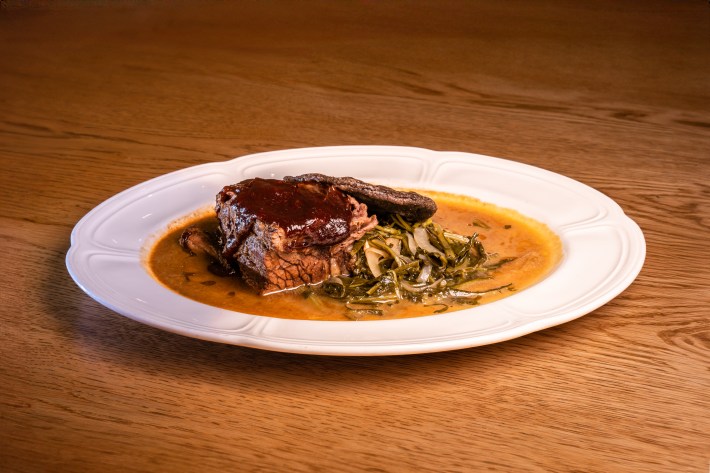
DeSpain’s menu at Abernethy’s is full of intriguing dishes combining flavors and techniques vital to Indigenous northern and central American lands. There’s a smoked dip based on tepary beans shared by both Mexico and the U.S. Southwest, made with maple chile oil and spiced corn nuts, served on a corn tostada. Entrees include a steak of braised bison bearing a berry barbecue sauce with braised dandelion greens a blue corn cake and corn-crusted fried quail with an agave-and-chipotle glaze. You can get any of these with a side like duck fat wild rice or a succotash made with nopales.
DeSpain describes herself as a “storyteller” through her food, pinpointing her “Three Sisters” tostada as a dish that sums up her culinary spirit through its descriptive telling of the historic, symbiotic relationship between squash, beans, and corns growing closely together in traditional Indigenous farms and milpas.
“I think this is a perfect representation of that fusion,” DeSpain says. “ I think that's the most significant dish on the menu because of that beautiful story. And it's the story that I like to, like, kind of, you know, push within us amongst people. You know, we're all created equal, and we are all relatives, and we should all be celebrated that way as well, helping one another thrive and shine together. And, of course, you have the hoja santa salsa verde on there that brings in the ties to indigenous cuisine from Oaxaca and from Mexico.”
DeSpain loves coming to people’s tables to talk and discuss her dishes and their origins. When not cooking for people who get nominated for Emmys or have the money for Music Center shows, she is an active educator who travels the country discussing Indigenous culture, history, stories, and wellness, working with kids at Boys and Girls Clubs and tribal nation youth centers, while also indulging her interest in learning about other Indigenous communities around the world.
“I go in, and I'll bring a variation of different ingredients that maybe aren't available in their area for them to try,” she says. “I really love to allow them to explore the variations of ingredients that come from tribal nations and from America that are native here, and educating them on that.’”
She strives to serve dynamic cooking to diners at her residency and spark greater awareness among them.
“There isn't a lot of representation of Native American food out in the public, especially here in L.A.,” she says. “We have a few restaurants across the nation that have been doing really well… like Sean Sherman’s, and you have a few James Beard finalists, but the fact that it's never been done here in L.A., I think is pretty crazy. I think people are more surprised about how familiar they are with the ingredients that are Indigenous to the Americas, but didn't really know any of the cultural significance behind them.”
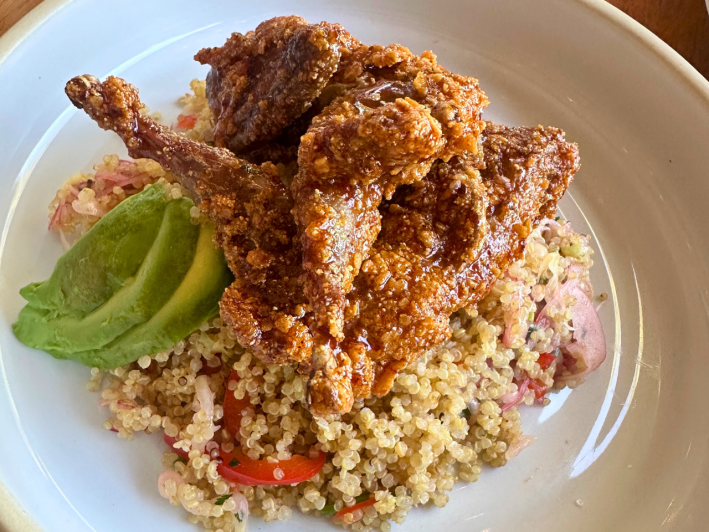
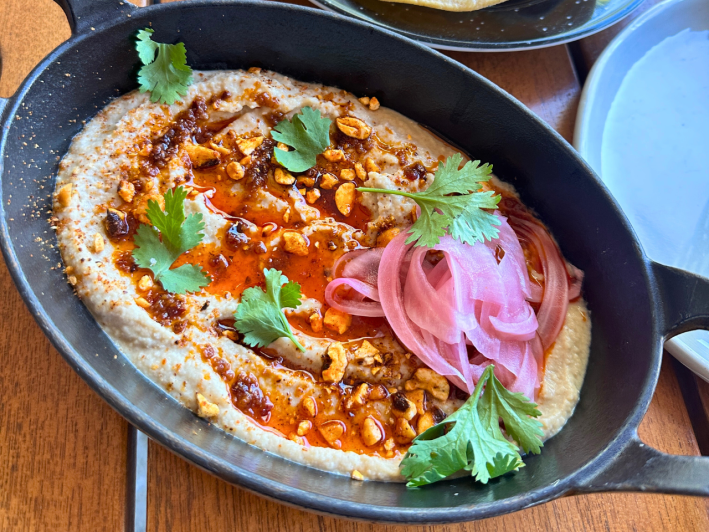
DeSpain’s heritage mirrors her cooking in all its deeply rooted connections and cultural interplay.
Her paternal grandfather, who “wasn’t in the picture,” was from Mexico City. Her grandmother is a Caucasian woman of Spanish-French heritage who fell in love with Mexican culture and cooking, raising Pyet’s father on the cuisine.
“She made sure that he and his siblings knew exactly where their roots come from and made sure they grew up with the culture,” DeSpain notes.
DeSpain’s mother is Native and herself had a Mexican father, but was adopted by a man from Guanajuato. She credits her cooking-obsessed family and growing up in Kansas City, where various members of father’s family owned taquerias and restaurants popular with the community that she bussed and served tables at, for imbuing her a foundational knowledge of Mexican cuisine and the Spanish language.
“I know who I am, and the food is meant to represent me,” she says. “By no means am I trying to tell people, ‘This is native food,’ ‘these are ancient recipes.’ No, I try to explain to them that this is the knowledge of my ancestors and the flavors and ingredients of what my ancestors ate pre-colonization, and the food you're eating represents who I am, which is a blend of these cultures.”
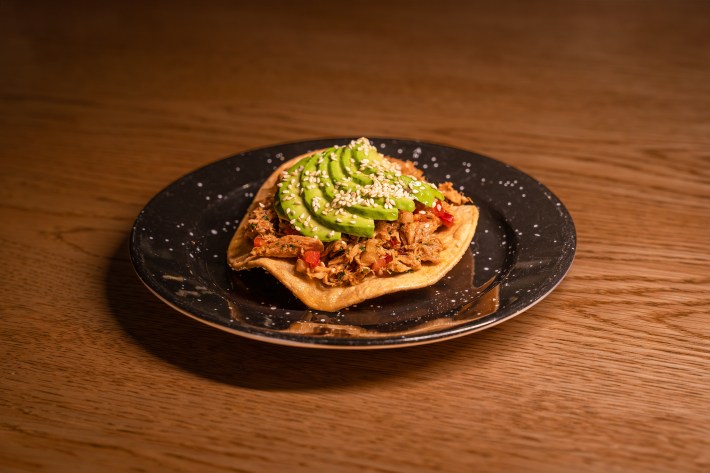
The 33-year-old chef hopes to help young people decolonize their diets, as much for health as for self-knowledge and greater unity.
“You know, there's an entire movement of decolonizing the diet, which I think is a beautiful, beautiful movement,” she notes. “I had the pleasure of having that experience, of being on a reservation at a young age and seeing the culture and seeing, oh, there's a lack of specific dishes and ingredients that we don't see at our table, but we will see them at the ceremony."
Being one of a small handful of Native American chefs, especially one with a growing public profile who represents Indigenous cooking on various cooking shows, is not a responsibility the chef takes lightly.
“As I got older, I realized, ‘Hey, why aren't we incorporating more of these quote/unquote “ceremonial foods” in our everyday life?,’” DeSpain continues. “And I think it was because, ‘oh, these are special foods, these are celebratory foods,’ but I think it's best to take the modern-day approach and say, ‘hey, we can bring those to our current table utilizing the knowledge and the intention behind what we would typically be using them for at ceremony but bringing that ceremony into our everyday life and inviting it in.’
“For me, having that very clear vision of not just doing it for the sake of Native food, but also Mexican food, and letting people understand the storyline is, you know, ‘the border crossed us, we didn't cross the border.’ And the thing that separates indigenous people of the Americas are these borders and influences of colonizing countries. I try to explain how these ingredients just come from different regions and there was a time where these indigenous tribal people were trading and bartering amongst one another with food, with clothing, you know, with different types of materials that they survive off of.”
Being one of a small handful of Native American chefs, especially one with a growing public profile who represents Indigenous cooking on various cooking shows, is not a responsibility the chef takes lightly.
“ I went on national television also and I said, ‘oh, I want to be the voice of Indigenous people in the culinary world,’” she recounts, admitting she didn’t know at that point exactly what that would always entail. “I said that on national television… I want to be able to represent these people and this cuisine and these foods in such a positive way. And I understand the pressure of that is to, you know, be very careful of my words and have respect for others that even if, you know, they have their agenda and they have their vision for their food, their cuisine, and maybe it's not aligned with mine, but we're all Indigenous and we obviously want to love and respect each other and lift each other up.”
DeSpain admires other Indigenous chefs and the various paths they take. She respects that some may take a stance on serving fry bread or take a stand on playing with Native recipes or changing the way they cook to please other people’s palates.
“I love that chefs that are going that route,” she tells us. “I like to take a different approach… I don't want people to think, like, ‘oh, like I'm not indigenous, so I can't eat this food or I can't respect it and enjoy it because my ancestors are the ones that did this.’ The goal of my food is to bring people in and have them feel welcome at the table while educating them and inviting them to embrace our culture in a warm, loving, and welcoming way. I think as long as I continue to do it with good intention and educate the public on it, then I think it's fine.”
As to how an Indigenous kitchen might be able to aid more direct political action, like the Land Back movement, DeSpain thinks her residency can be a part of the puzzle, if not overtly bringing the issue directly into her culinary storytelling.
“I think the simple fact that there is [a Native American] presence, and there are other chefs here that they just haven't had the opportunity to be highlighted,” she says. “Just having the residency alone speaks volumes for itself.”
DeSpain is also using the residency to bring attention to Native issues, displaying a big mural from Native artist Lauren "Siyowin" Peters that calls attention to the MMIW (Missing and Murdered Indigenous Woman) epidemic, with a massive red handprint over the faces of a Native man and woman.
“This is my opportunity to not just highlight myself, but highlight artists that are local here in Los Angeles and give them the opportunity to shine and also bring awareness to these important topics,” she says. “So it may not be a land back movement, but it is a movement that we are making sure is present and known.”
After DeSpain’s residency at Abernethy’s ends in six months next spring, she feels better positioned to know what’s next, be it opening a restaurant or finding other ways of making Native cooking more present in L.A.
In the meantime, she’s busy putting together a cookbook of Indigenous fusion recipes that will hopefully come out in February and include some of the dishes from her Abernethy’s menu.
You’ll also see her on television, as she still competes on shows on The Food Network and other culinary-minded channels. She also hints that she’s got a project under wraps that will allow her to be “a host and also a producer and highlight Indigenous communities.”
“I've always been a very ambitious person even before I won Next Level Chef,” DeSpain says. “I've always wanted to, you know, be a voice for people. And I've always wanted to just share what I believe is, like, the light and the truth of the world and the divine and whatever that is, you know. And what speaks true to me is to do it through the food… So if that means, I’m on TV doing it, then I love it. If that means I'm just within communities doing it, like I have been, I'll continue to do that. In whatever way I feel called to share that light, I'm going to keep doing that.”
Chef Pyet DeSpain's Culinary Residency at Abernethy's, now until Spring 2025 ~ 220 N Hope St. Los Angeles, California 90012
